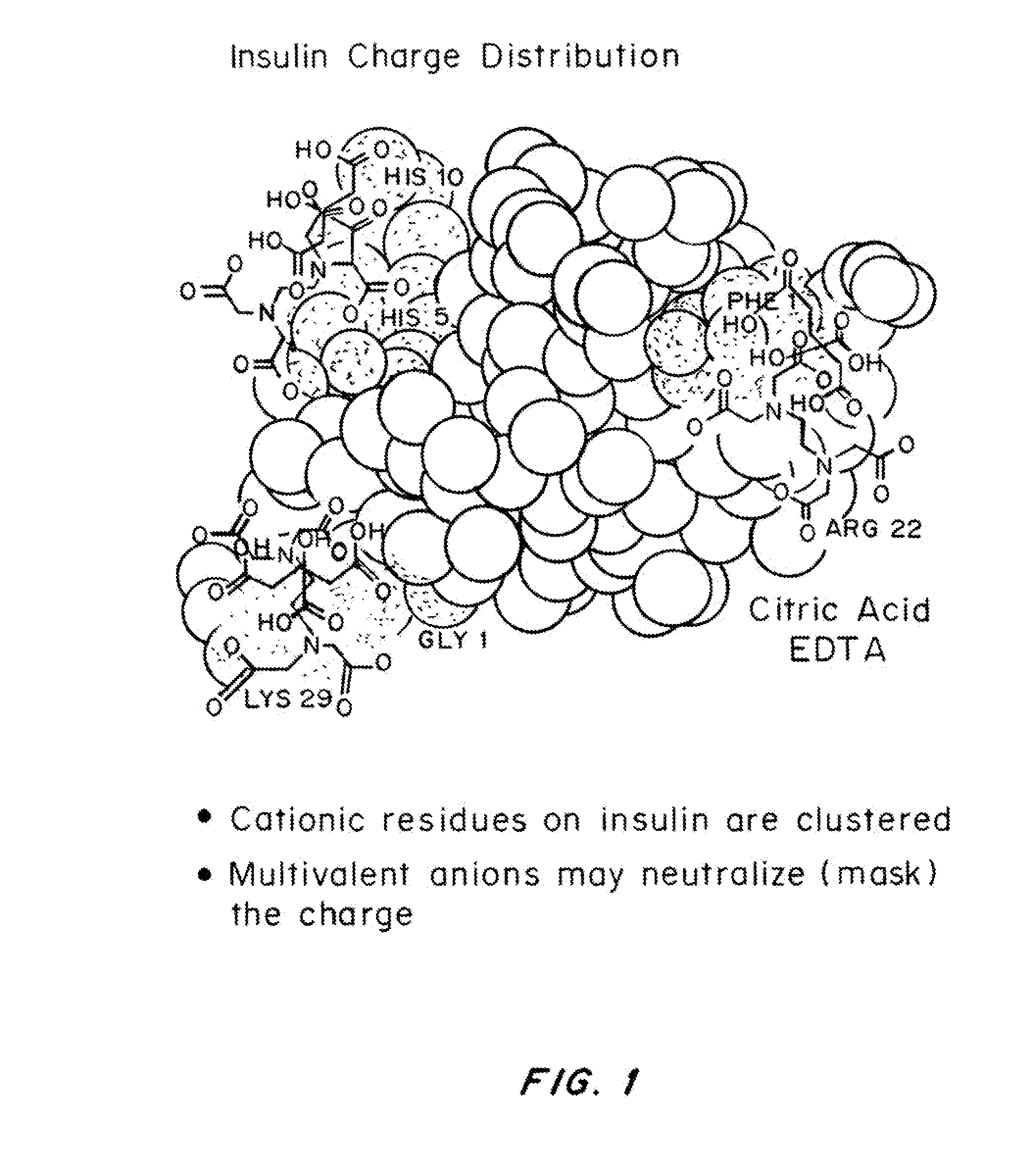Magnesium Compositions for Modulating the Pharmacokinetics and Pharmacodynamics of Insulin and Insulin Analogs, and Injection Site Pain
a technology of magnesium compositions and compositions, applied in the direction of peptide/protein ingredients, inorganic non-active ingredients, metabolic disorders, etc., can solve the problems of interfering with the ability of proteins, abnormally high blood glucose level of patients with diabetes, and inadequate insulin levels, etc., to achieve the effect of improving the tolerability of injection sites
- Summary
- Abstract
- Description
- Claims
- Application Information
AI Technical Summary
Benefits of technology
Problems solved by technology
Method used
Image
Examples
example 1
Effect of Calcium disodium EDTA Concentration on Injection Site Discomfort in Humans
[0099]Materials and Methods
[0100]Each milliliter of VIAJECT® 7 (VJ 7) contains: 3.7 mg (100 IU) of recombinant human insulin, 1.8 mg of citric acid, 1.8 mg of disodium EDTA, 22.07 mg of glycerin, 3.0 mg of m-Cresol as a preservative, and sodium hydroxide and / or hydrochloric acid to adjust the pH to approximately 7.
[0101]Each milliliter of BIOD 102 contains: 3.7 mg (100 IU) of recombinant human insulin, 1.8 mg of citric acid, 2.4 mg of calcium disodium EDTA, 15.0 mg of glycerin, 3.0 mg of m-cresol as a preservative, and sodium hydroxide and / or hydrochloric acid to adjust the pH to approximately 7.1.
[0102]Each milliliter of BIOD 103 contains: 3.7 mg (100 IU) of recombinant human insulin, 1.8 mg of citric acid, 0.25 mg of disodium EDTA, 2.0 mg of calcium disodium EDTA, 15.0 mg of glycerin, 3.0 mg of m-cresol as a preservative, and sodium hydroxide and / or hydrochloric acid to adjust the pH to approximate...
example 2
Study of the Rate of Insulin Absorption of Formulations BIOD 105 and BIOD 107 in Miniature Diabetic Swine
[0110]The aim of this study was to evaluate the pharmacokinetic (PK) and pharmacodynamic (PD) properties of modified insulin formulations predicted to be associated with improved toleration. The addition of calcium EDTA to an insulin formulation (containing disodium EDTA) was shown in Example 1 to reduce the site reaction to the injection when compared to an insulin formulation containing disodium EDTA, without added calcium EDTA); however, the rapid action of the formulation was somewhat delayed from this substitution. Therefore, new insulin formulations were developed to regain the loss in timing (rapid action), and to improve stability. Additional citric acid was added (150% compared to the original formulation, VJ 7) to some formulations, and a ⅓ reduction in m-cresol was explored, to enhance stability.
[0111]In one of the new formulations, disodium EDTA and CaCl2 were added a...
example 3
Insulin Formulations Containing Magnesium Salts
[0124]The effect of magnesium salts on the pharmacokinetics, pharmacodynamics and injection site discomfort obtained with insulin formulations containing disodium EDTA was assessed, compared to HUMLAOG®. Each milliliter of HUMLAOG® contains: insulin lispro 100 units, 16 mg glycerin, 1.88 mg dibasic sodium phosphate, 3.15 mg Metacresol, zinc oxide content adjusted to provide 0.0197 mg zinc ion, trace amounts of phenol, and water for Injection. Insulin lispro has a pH of 7.0 to 7.8. The pH is adjusted by addition of aqueous solutions of hydrochloric acid 10% and / or sodium hydroxide 10%.
[0125]Materials and Methods
[0126]Insulin formulations were prepared as described above in Table 1.
[0127]The formulations were evaluated in 12 human volunteers. The Demographic / Baseline information and Dose Summary are described in Table 6.
TABLE 6Demographic / Baseline and Dose SummaryVariableStatistic / CategorySexFemale (%) 2 (16.7%)Male (%)10 (83.3%)RaceBlack...
PUM
| Property | Measurement | Unit |
|---|---|---|
| Molar density | aaaaa | aaaaa |
| Molar density | aaaaa | aaaaa |
| Molar density | aaaaa | aaaaa |
Abstract
Description
Claims
Application Information
 Login to View More
Login to View More - R&D
- Intellectual Property
- Life Sciences
- Materials
- Tech Scout
- Unparalleled Data Quality
- Higher Quality Content
- 60% Fewer Hallucinations
Browse by: Latest US Patents, China's latest patents, Technical Efficacy Thesaurus, Application Domain, Technology Topic, Popular Technical Reports.
© 2025 PatSnap. All rights reserved.Legal|Privacy policy|Modern Slavery Act Transparency Statement|Sitemap|About US| Contact US: help@patsnap.com



